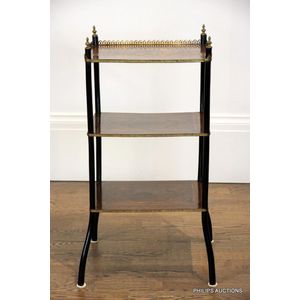French Inlaid Three Tier Whatnot
You must be a subscriber, and be logged in to view price and dealer details.
Subscribe Now to view actual auction price for this item
When you subscribe, you have the option of setting the currency in which to display prices to $Au, $US, $NZ or Stg.
- Gallery - On furniture, a gallery is a small upright section, frequently pierced and decorated, around the tops of small items of furniture, such as davenports, side tables, and so forth. Galleries are made in brass or bronze,and be fretted, pierced or solid timber. A three-quarter gallery is one that surrounds three of the four sides of a table, desk or other top.
- Parquetry - Parquetry is inlay laid in geometric patterns, the contrast being achieved by the opposing angles of the grain and veneers. The herringbone pattern is the most commonly used in flooring, but this is almost never seen in furniture - the patterns used are more complex and unlike flooring, can include several different varieties of timber.
- Pierced Decoration - Ornamental woodwork with part of the background cut through and removed to produce an open-work pattern.
- Inlay - Decorative patterns inserted into the main body of a piece of furniture, generally in wood of contrasting colour and grain, though brass, ivory, ebony, shell and sometimes horn have been used. Inlay may consist of a panel of well figured timber inset into a cabinet door front, geometric patterns, or complex and stylized designs of flowers, swags of foliage, fruits and other motifs. As a general rule, in pieces where the carcase is constructed in the solid, the inlay is relatively simple such as stringing, cross banding and herringbone banding. Where more elaborate and decorative work was required veneer was used. Inlay has been fashionable from at least the latter half of the 17th century, when a variety of elaborate forms were developed
- Tier - One or more under-shelves of a table or cabinet.
- Ebonised - Timber that has been stained or lacquered black in imitation of ebony. The process has been used since the Renaissance, but is most commonly found in late 19th century furniture, sometimes gilded and turned in imitation of bamboo. Furniture with an ebonised finish is not currently in vogue, and this is reflected in the price for such pieces.
This item has been included into following indexes:
Visually similar items

Antique walnut 2 tier occasional table 76 cm x 51 cm, 71 cm high

A Victorian walnut Medieval revival table, mid 19th century, the rectangular table having a quarter veneer panelled top, above a central shelf and conforming lower stretcher, the shaped side panels pierced and profusely carved in the manner of medieval sto

A Regency mahogany turned leg side table c.1820. The table has a scalloped shaped full length single drawer, with gilt metal circular drop handles. Height 77 cm. Width 94.5 cm. Depth 54 cm

An antique inlaid etagere in tulipwood and burr walnut, later 19th century, with a serpentine rectangular profile, the three tiers with quarter veneer walnut panels surrounded by wide tulipwood cross banded borders with gilt bronze trims, the top inlaid wi
